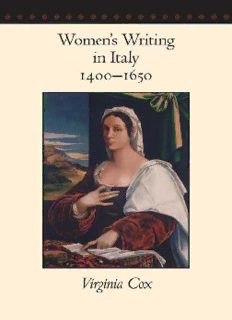
Women's writing in Italy, 1400-1650 PDF
Preview Women's writing in Italy, 1400-1650
women’s writing in italy, 1400–1650 This page intentionally left blank (cid:2) (cid:2) (cid:2) (cid:2) Women’s Writing in Italy 1400 1650 – (cid:2) Virginia Cox THE JOHNS HOPKINS UNIVERSITY PRESS Baltimore This book was brought to publication with the generous assistance ofthe Gladys Krieble Delmas Foundation. ©2008The Johns Hopkins University Press All rights reserved. Published 2008 Printed in the United States ofAmerica on acid-free paper 2 4 6 8 9 7 5 3 1 The Johns Hopkins University Press 2715North Charles Street Baltimore, Maryland 21218-4363 www.press.jhu.edu Library ofCongress Cataloging-in-Publication Data Cox, Virginia. Women’s writing in Italy, 1400–1650/ Virginia Cox. p. cm. Includes bibliographical references and index. ISBN-13:978-0-8018-8819-9(hardcover : alk. paper) ISBN-10:0-8018-8819-0(hardcover : alk. paper) 1. Italian literature—Women authors—History and criticism. 2. Italian literature—History and criticism. 3. Women and literature— Italy—History. I. Title. PQ4063.C692008 850.9′9287—dc22 2007036098 A catalog record for this book is available from the British Library. Special discounts are available for bulk purchases ofthis book. For more information, please contact Special Sales at 410-516-6936or [email protected]. The Johns Hopkins University Press uses environmentally friendly book ma- terials, including recycled text paper that is composed of at least 30percent post-consumer waste, whenever possible. All ofour book papers are acid-free, and our jackets and covers are printed on paper with recycled content. For Paul This page intentionally left blank contents Acknowledgments ix Introduction xi chapter one. Origins (1400–1500) 1 1 . The “Learned Lady” in Quattrocento Italy: 2 An Emerging Cultural Type 2 . The “Learned Lady” in Theory: Models of Gender Conduct 17 and Their Contexts 3 28 . The “Learned Lady” as Signifier in Humanistic Culture 4 34 . Renaissance Particularism and the “Learned Lady” chapter two. Translation (1490–1550) 37 1 38 . Women, the Courts, and the Vernacular in the Early Sixteenth Century 2 45 . Sappho Surfaces: The First Female Vernacular Poets 3 53 . Bembo, Petrarchism, and the Reform of Italian Literature 4 1530 64 . “So Dear to Apollo”: Veronica Gambara and Vittoria Colonna after 5 . Founding Mothers, First Ladies: Gambara and Colonna 76 as Models and Icons chapter three. Diffusion (1540–1560) 80 1 80 . Manuscript and Print in the “Age of the Council of Trent” 2 91 .VirtùRewarded: The Contexts of Women’s Writing 3 99 . Women Writers and Their Uses: Case Studies 4 108 . Literary Trajectories: Continuity and Change 5 118 . Women Writers and the Paradox of the Pedestal chapter four. (1560–1580) 121 INTERMEZZO chapter five. Affirmation (1580–1620) 131 1 131 . Women’s Writing in the Age of the Counter-Reformation 2 138 . Chivalry Undimmed: The Contexts of Women’s Writing 3 149 . A Literature of Their Own? Writing, Ownership, Assertion 4 163 . The Twilight of Gallantry viii Contents chapter six. Backlash (1590–1650) 166 1 166 . The Rebirth of Misogyny in Seicento Italy 2 195 . Misogyny and the Woman Writer: The Redomestication of Female Virtù 3 204 . Women’s Writing in Seicento Italy: Decline and Fall Coda 228 Appendix A. Published Writings by Italian Women, 235 Fifteenth to Seventeenth Centuries 247 Appendix B. Dedications of Published Works by Women 255 Notes 377 Bibliography 447 Index acknowledgments This book pulls together the findings and musings of almost twenty years ofteaching and researching the literary history ofwomen’s writing in Italy. My intellectual debts are correspondingly vast, and I cannot hope to sum- marize them adequately here. The field has expanded and developed be- 1980 yond measure since I first started to interest myself in it in the late s. It has been an immensely gratifying experience, in all kinds ofways, to par- ticipate in this exploratory and still pioneering phase in the critical tradi- tion, but not least of the gratifications it has offered has been the oppor- tunities for dialogue and collaborative work. I feel a particular debt to my earliest interlocutors on the subject, back 1980 1990 in the late s and early s, Letizia Panizza, Pam Benson, and Adriana Chemello; also to Letizia Panizza, again, and to Pam Benson (in collabo- ration with Vicky Kirkham) for organizing two superb conferences in this area, respectively at Royal Holloway and Bedford New College, London, 1994 2000 in , and at the University of Pennsylvania in , which did much to shape my understanding of the field.1 Another particular debt I should like to mention is to Al Rabil, who has proved himself an extraordinary promoter of work in this area. Two Na- tional Endowment for the Humanities institutes Al organized in North 2001 2003 Carolina in and onWomen’s Writing in Venice, Paris, and London, 1550 1700 fi – contributed immensely to my scholarly development in this eld, by offering me the opportunity to work together with Anne Schutte as a coordinator of the Venice segment and to meet and learn from a series of fi younger emerging scholars in the eld such as—to mention only those ac- tive in the area of Italian studies—Babette Bohn, Julie Campbell, Maria Galli Stampino, Julia Hairston, Liz Horodowich, Julia Kisacky, Suzanne Maganini, Marjorie Och, and Lori Ultsch. I had the great good fortune to have as my earliest PhD students at Cambridge in the 1990s Abigail Brundin and Lisa Sampson and have greatly profited from my conversation and collaborations with them over the years. It is my equal good fortune now to have Jane Tylus as a colleague and interlocutor in the Department of Italian at NYU. Other scholars and graduate students working in the field from whom I have had the opportunity to learn in person as well as through their published work, or who have shared their work with me or helped me ix
Description: